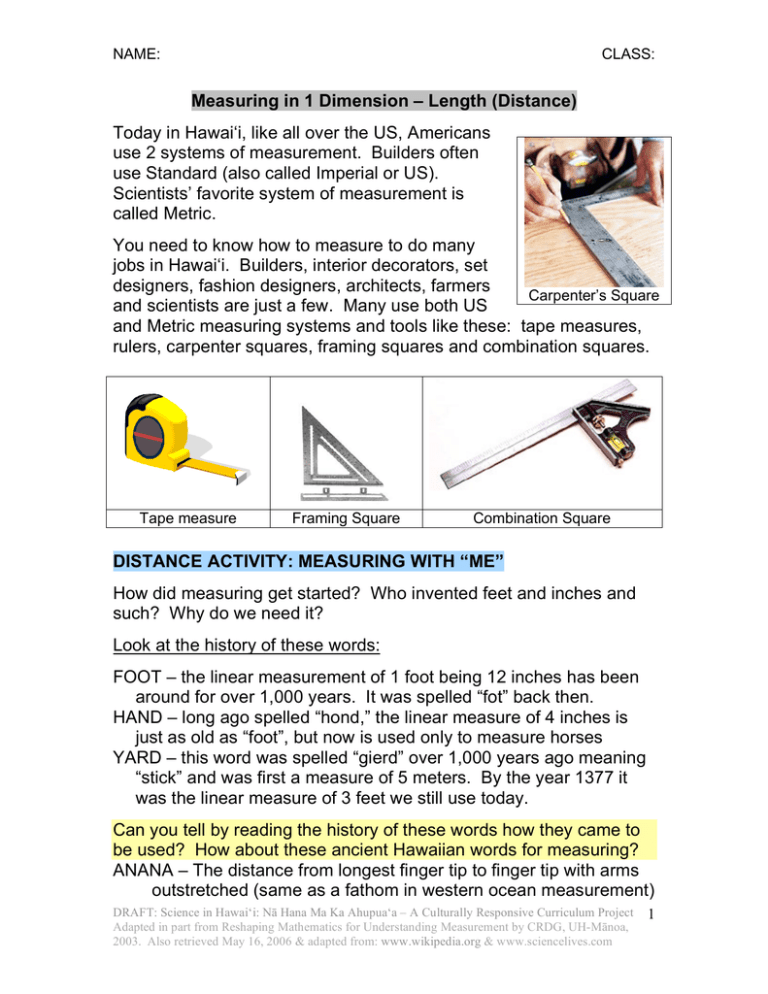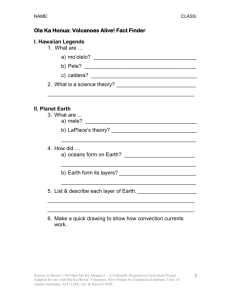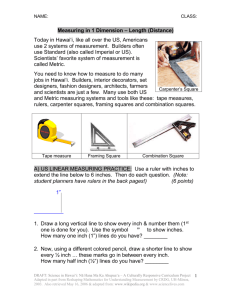Measuring in 1 Dimension – Length (Distance)
advertisement

NAME: CLASS: Measuring in 1 Dimension – Length (Distance) Today in Hawai‘i, like all over the US, Americans use 2 systems of measurement. Builders often use Standard (also called Imperial or US). Scientists’ favorite system of measurement is called Metric. You need to know how to measure to do many jobs in Hawai‘i. Builders, interior decorators, set designers, fashion designers, architects, farmers Carpenter’s Square and scientists are just a few. Many use both US and Metric measuring systems and tools like these: tape measures, rulers, carpenter squares, framing squares and combination squares. Tape measure Framing Square Combination Square DISTANCE ACTIVITY: MEASURING WITH “ME” How did measuring get started? Who invented feet and inches and such? Why do we need it? Look at the history of these words: FOOT – the linear measurement of 1 foot being 12 inches has been around for over 1,000 years. It was spelled “fot” back then. HAND – long ago spelled “hond,” the linear measure of 4 inches is just as old as “foot”, but now is used only to measure horses YARD – this word was spelled “gierd” over 1,000 years ago meaning “stick” and was first a measure of 5 meters. By the year 1377 it was the linear measure of 3 feet we still use today. Can you tell by reading the history of these words how they came to be used? How about these ancient Hawaiian words for measuring? ANANA – The distance from longest finger tip to finger tip with arms outstretched (same as a fathom in western ocean measurement) DRAFT: Science in Hawai‘i: Nā Hana Ma Ka Ahupua‘a – A Culturally Responsive Curriculum Project Adapted in part from Reshaping Mathematics for Understanding Measurement by CRDG, UH-Mānoa, 2003. Also retrieved May 16, 2006 & adapted from: www.wikipedia.org & www.sciencelives.com 1 NAME: CLASS: MUKU – From finger tips of one arm to the elbow of the other arm IWILEI – The length of one arm from collarbone to finger tip With a partner, try using your feet, hands and arms as units of measure to measure the distance from one end of your classroom to the other. Step 1: Estimate first! How many units long is your class? Write this for each unit of measurement – feet, hand, arms. Step 2: Measure! Write down how many units long your class is for each unit of measurement. Body Part (Unit Of Measurement) FOOT My Estimate (of length of classroom) My Measure (of length of classroom) HAND ARMS OTHER: BONUS: make a tape measure on paper or cardboard with your foot or hand as the unit of measure. Explain if this is as good as a ruler. DRAFT: Science in Hawai‘i: Nā Hana Ma Ka Ahupua‘a – A Culturally Responsive Curriculum Project Adapted in part from Reshaping Mathematics for Understanding Measurement by CRDG, UH-Mānoa, 2003. Also retrieved May 16, 2006 & adapted from: www.wikipedia.org & www.sciencelives.com 2



